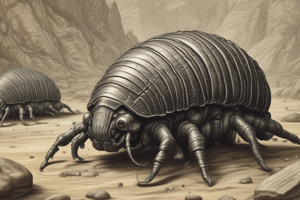Podcast
Questions and Answers
What is the classification of trilobites?
What is the classification of trilobites?
- Arthropoda (correct)
- Mammalia
- Reptilia
- Insecta
Trilobites are called trilobites as their exoskeleton is divided into _____ lobes.
Trilobites are called trilobites as their exoskeleton is divided into _____ lobes.
3
What is an arthropod skeleton made of?
What is an arthropod skeleton made of?
Chitin
The exoskeleton of arthropods is flexible and allows for growth.
The exoskeleton of arthropods is flexible and allows for growth.
What does the cephalon of a trilobite consist of?
What does the cephalon of a trilobite consist of?
What is the purpose of the facial sutures in trilobites?
What is the purpose of the facial sutures in trilobites?
What does ecdysis refer to?
What does ecdysis refer to?
What does the pygidium of a trilobite do?
What does the pygidium of a trilobite do?
The thorax is made up of thoracic segments, each possessing a pair of ______ and ______.
The thorax is made up of thoracic segments, each possessing a pair of ______ and ______.
Match the following parts of the cephalon with their functions:
Match the following parts of the cephalon with their functions:
The thorax of trilobites is characterized by which feature?
The thorax of trilobites is characterized by which feature?
Flashcards are hidden until you start studying
Study Notes
Classification of Trilobites
- Earliest known organisms in the phylum Arthropoda, which includes lobsters, crabs, and spiders.
- Class Trilobita characterized by exoskeleton divided into three lobes along a longitudinal axis.
- Three main body sections: cephalon (head), thorax, and pygidium (tail).
- Originated in the Cambrian period and went extinct by the end of the Permian period.
Arthropod Skeleton
- Features a hard exoskeleton made of chitin, providing muscle attachment and armor-like protection.
- Composed of jointed appendages such as legs and antennae, essential for movement and feeding.
- Each pleuron is equipped with jointed legs for locomotion or swimming and may have gills for respiration.
- Preservation of appendages is rare, exemplified by findings in the Burgess Shale.
Exoskeleton Structure
- Comprises three layers: a waxy outer layer, with two inner layers of chitin and protein.
- Middle layer may include calcium carbonate to enhance strength.
- Sensory hairs possibly emerged from the exoskeleton for environmental detection.
Cephalon Composition
- Includes structures like eyes, facial sutures, free cheeks, fixed cheeks, and glabella.
- Compound eyes are similar to modern arthropods with multiple calcite lenses, allowing for wide-angle vision.
- Spines at the glabella may serve as defense or help distribute body weight.
Cephalon - Free Cheeks (Librigenae)
- These parts detach from the skeleton during ecdysis (molting).
Cephalon - Glabella
- Forms as a result of the stomach's position within the head structure.
Cephalon - Facial Sutures
- Weakness lines in the exoskeleton that break first during ecdysis, important for the organism's molting process.
Cephalon - Facial Sutures Types
- Proparian: located forward of the genal angle (common in Phacopina).
- Gonatoparian: situated at the genal angle (common in Calymenina).
- Opisthoparian: runs along the hind cephalic margin adjacent to the genal angle.
Cephalon - Fixed Cheek (Fixigena)
- Stays attached to the exoskeleton during the start of ecdysis.
Cephalon - Genal Angle
- Possible location for spines; angle measurements available in some species.
Cephalon - Appendages (Headlegs)
- Utilize for environmental sensing and feeding.
Thorax Structure
- Composed of thoracic segments, each with a pair of appendages and gills.
- Individual plates articulate for flexibility, enabling defensive curling (enrolment).
- Each thoracic segment consists of two pleurae and a segment from the axis.
Thorax - Thoracic Segment
- Each segment is made up of three articulated plates.
Thorax - Pleuron
- Segment adjacent to the main axis of the thorax.
Thorax - Appendages for Movement
- Appendages facilitate locomotion or are linked to gill structures for respiration.
Dorsal Morphology
- Refers to the upper side of the organism.
Ventral Morphology
- Pertains to the underside anatomy of the organism.
Pygidium Structure
- Comprised of several fused segments, potentially with spines to stabilize the animal.
Ecdysis Process
- Similar to modern arthropods like crabs, trilobites underwent molting, where the exoskeleton couldn’t grow.
- Ecdysis results in fractures along facial sutures, facilitating the shedding process.
Studying That Suits You
Use AI to generate personalized quizzes and flashcards to suit your learning preferences.




